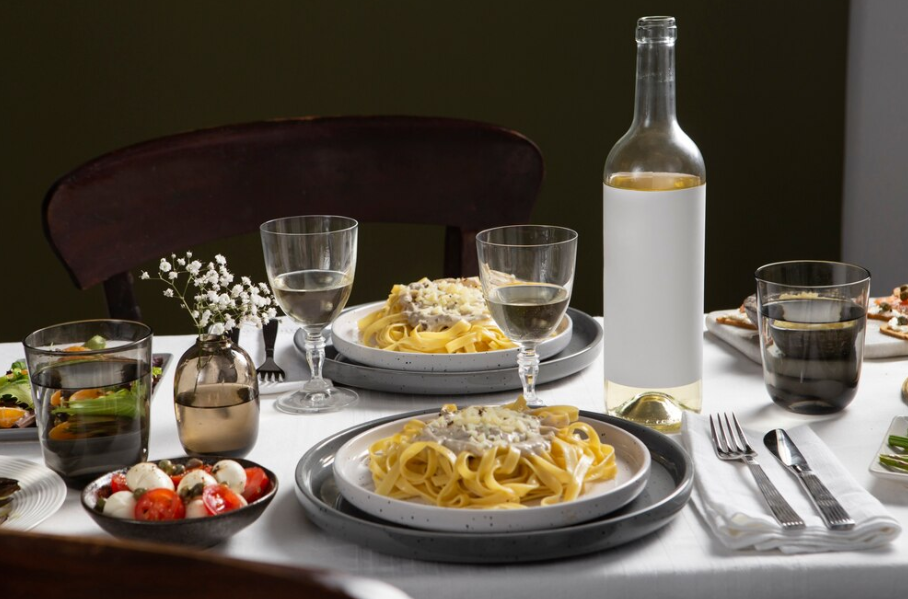What is Pinot Gris
Pinot Gris is a white wine grape variety with a unique flavor and a direct genetic link to the well-known Pinot Noir. This mutation has given rise to a grape that adapts well to various climates and regions around the world, resulting in a wide range of flavor profiles depending on where it is grown.
This post explores all aspects of Pinot Gris, from how to pronounce its name and its flavor characteristics to its key growing regions and the different styles of wine it produces. It also provides practical advice on the best food pairings to complement this versatile wine. Whether already familiar with wine or just getting started, this guide offers a thorough understanding of Pinot Gris.
What You Need to Know About Pinot Gris Wine
Pinot Gris is a versatile aromatic white wine that varies significantly in taste depending on where it’s grown and how it’s made. This wine typically presents a medium body and is characterized by its vibrant, juicy flavors often reminiscent of stone fruits such as peaches and apricots. The profile of Pinot Gris can shift from light and zesty to rich and full-bodied, with some varieties offering hints of spice alongside a subtle sweetness.
This adaptability not only makes it a favorite among wine lovers but also an excellent choice for pairing with a variety of dishes. Its refreshing quality makes it a hit at casual gatherings like BBQs, yet its complex notes can complement the refined flavors of a sophisticated dinner party. Additionally, the wine’s acidity and fruitiness can cut through richer, creamier dishes or enhance the delicate flavors of seafood and poultry. Whether you’re hosting a summer picnic or a formal meal, it offers a delightful option that appeals to a broad range of palates.
How to Pronounce Pinot Gris Correctly
Pinot Gris, often pronounced as “pee-noh gree,” is a French term where each component of the name is articulated distinctly. The word “pinot,” meaning “pine” in French, due to the grape clusters’ resemblance to pine cones, is pronounced “pee-noh,” with the stress placed on the first syllable. The second part, “gris,” meaning “gray” in French, which reflects the grayish-blue color of the grape skins, is pronounced “gree” and features a soft “g” sound.
Flavor Profile of Pinot Gris Wines
These wines are known for their dynamic flavors, typically medium to full-bodied with a refreshing acidity. They are highly aromatic, featuring fruit flavors like citrus, apple, pear, melon, and tropical fruits, which vary based on vineyard and climate. Some may also have floral and subtle spice notes, adding complexity.
The flavor diversity of wine is greatly influenced by the grape’s growing region and winemaking methods. For example, wines from cooler regions often have crisp fruit flavors and higher acidity, making them great for pairing with food. Wines from warmer areas might be richer with less acidity. This makes wine versatile and popular worldwide, suitable for pairing with various dishes.
Pinot Grigio: Is it Sweet or Dry?
Pinot Grigio is generally on the drier side of the wine sweetness spectrum but can be semi-sweet depending on the region and production methods. It’s typically drier than its variant, Pinot Gris, which can be sweeter when grown in warmer climates compared to cooler ones. This variation shows how local climate and winemaking techniques influence the wine’s taste, contributing to the wide appeal of Pinot Grigio/Pinot Gris among wine enthusiasts.
Pinot Gris vs. Pinot Grigio: What’s the Difference?

Pinot Gris and Pinot Grigio are made from the same grape but are named differently to reflect the distinct styles and winemaking traditions of France and Italy, respectively. Pinot Gris, primarily from France’s Alsace region, is usually rich and sometimes sweet, with flavors of honey, almond, spices, and ripe fruit. It tends to be fuller-bodied, with lower acidity and higher alcohol content.
In contrast, Pinot Grigio from Italy, especially the Lombardy region, is crafted to be lighter and crisper, emphasizing fresh flavors of citrus and green apples with a clean finish. It is generally more acidic and less alcoholic than Pinot Gris.
These differences not only affect the taste but also influence how these wines are described and used in pairing with food. “Pinot Gris” usually denotes the richer French style, while “Pinot Grigio” refers to the lighter, sharper Italian version. Understanding these distinctions can help in selecting the right wine for different foods and personal preferences.
Comparing with Popular Wine Varieties
- Chardonnay vs Pinot Grigio: Wine enthusiasts often regard Chardonnay as a more complex wine, boasting deeper flavors than Pinot Grigio. Both oaked Chardonnay and oaked Pinot Grigio share similarities like vanilla aromas and a creamy, buttery texture. While Chardonnay is known for its distinctive notes of cut grass, apple, vanilla, and pineapple, Pinot Grigio is celebrated for its lighter, sweeter, and more aromatic profile.
- Sauvignon Blanc vs Pinot Grigio: A notable difference between Sauvignon Blanc and Pinot Grigio lies in their aromas. Sauvignon Blanc features vivid scents of grass, lime, and gooseberry, whereas Pinot Grigio’s aroma is more subdued. While both wines vary widely in sweetness and acidity due to different production methods, Pinot Grigio is typically more crisp and acts as a refreshing palate cleanser, though exceptions abound.
- Pinot Grigio vs Pinot Noir: The primary distinction between these two is color: Pinot Noir is a red wine, whereas Pinot Grigio is white. Both varieties offer a refreshing taste, but compared to richer red wines like Merlot or Syrah, Pinot Noir is lighter in color and taste, lacking significant acidity or tannins. Pinot Grigio, on the other hand, may exhibit a bit more sweetness and acidity, along with unique citrus flavors.
- Pinot Grigio vs Riesling: Both Pinot Grigio and Riesling are aromatic and fruity, often showcasing notes of apple, citrus, and stone fruits such as peach, lemon, and lime. Pinot Grigio, while sharing some of Riesling’s sweetness, typically has lower acidity and might be barrel-aged, which imparts a creamier texture and adds flavors of vanilla and honeysuckle.
- Moscato vs Pinot Grigio: Fans of Moscato might find a similar appeal in Pinot Grigio, as both wines are highly aromatic, sweet, and have a crisp finish. Although still Moscato might appear drier, the rich fruity flavors can make it seem sweeter. In terms of alcohol content, Pinot Grigio generally falls in the medium range (11-13% ABV), while Moscato is lighter, ranging from 5-7% ABV. For those who enjoy a sparkling touch, both Moscato and Pinot Grigio are available in bubbly varieties.
Key Characteristics of Pinot Gris Wine: Color and Texture
The wine features a color range from light pinkish-gray to deeper pink, which is due to the grape’s natural pigmentation. The term “gris” means gray in French, and the color intensity can vary based on the grape clone, ripeness at harvest, and winemaking techniques used.
The wine is also known for its slightly oily or viscous texture, which creates a rich mouthfeel. This texture results from higher glycerol levels produced during fermentation and can vary with the fermentation duration and temperature.
These properties make Pinot Gris versatile, pairing well with various dishes, from rich seafood to spicy Asian foods. Its unique color and texture enhance both its visual and culinary appeal, making it popular for various occasions.
Where Pinot Gris is Cultivated

Wine is cultivated in a variety of regions worldwide, each contributing unique characteristics to the wine due to differing climate conditions, soil types, and winemaking traditions. Among the most notable regions for Pinot Gris are:
- Alsace, France: This region is renowned for producing rich and aromatic Pinot Gris wines with a full body and complex flavor profiles, often with a hint of sweetness.
- Italy: Known locally as Pinot Grigio, Italian variants are typically lighter and crisper, reflecting the cooler growing conditions and the region’s winemaking style that emphasizes freshness and acidity.
- Oregon, United States: Oregon’s cool climate is ideal for cultivating Pinot Gris, producing wines that are vibrant and fruity, with a balance of acidity and minerality that is highly prized.
- New Zealand: In New Zealand, it is now the third most popular wine variety, showing significant growth in popularity. It is grown across the country, with regional climates influencing the wine’s characteristics. The cooler South Island regions produce Pinot Gris with higher acidity and stronger aromatics, while the warmer North Island yields wines with riper flavors and a more oily texture.
- Australia: Australian Pinot Gris, especially from cooler areas like Tasmania and the Adelaide Hills, tends to be rich and textured, often with a greater depth of fruit and sometimes a slight spice.
Styles of Pinot Gris Wine Across Different Regions
Pinot Gris is a flexible grape that can be made into different styles of wine, depending on the regional climate and local winemaking methods. These styles range from dry to off-dry, and even sweet wines, appealing to a wide range of wine enthusiasts.
- Alsace, France: In Alsace, it is often made into wines that are richer and more full-bodied. These wines typically have a slightly sweeter profile, thanks to the region’s cooler climate and the tradition of leaving the grapes on the vine longer to develop fuller flavors.
- Italy: Known as Pinot Grigio in Italy, the style here leans towards lighter and crisper wines, with a noticeably drier taste. This is reflective of the Italian preference for wines that complement their seafood and Mediterranean diets, influenced by the warmer growing conditions that tend to accelerate grape maturation and preserve natural acidity.
- Oregon, USA: American Pinot Gris, particularly from Oregon’s cool-climate Willamette Valley, showcases more exaggerated fruit flavors and slightly less acidity than its European counterparts. These wines are typically medium to full-bodied, marked by fresh citrus and ripe orchard fruit flavors, often with a hint of mineral or spice. Oregon’s diverse microclimates and innovative winemaking techniques contribute to the versatility and expressive character of its Pinot Gris.
- Germany: In Germany, known locally as Grauburgunder, Pinot Gris features a rich, full-bodied style balanced with lively acidity, sometimes enhanced by oak aging, which compares it to Chardonnay. Common flavors include ripe apples, pears, and a hint of honey, often accompanied by distinctive minerality. Regions like Pfalz and Baden are known for producing Grauburgunder with robust body and ripe, tropical fruit flavors, maintaining a refreshing acidity that adds balance and structure.
- Other Regions: New Zealand and Australian versions can vary widely but generally split the difference between the Alsatian richness and Italian crispness, depending on the specific climates of each vineyard area.
Serving Tips for Pinot Gris Wine
Have you ever noticed a difference in the taste of a bottle of wine purchased directly from a vineyard or during a holiday when you drink it at home? The temperature at which the wine is served and the type of glassware used can significantly affect the flavor of your wine.
- Serving Temperature: Pinot Gris, being an aromatic white wine, should be served chilled but not excessively cold. The ideal temperature is around 7°C. Serving it colder than this can mute some of the wine’s flavors and aromas.
- Glassware: A traditional white wine glass, which is wider than a champagne flute but narrower than a large red wine glass, is optimal for Pinot Gris. Drinking Pinot Gris from this type of glass directs the wine to the center of your mouth, away from the sides where you perceive acidity. The glass’s shape also helps to retain the delightful aromas of Pinot Gris, enhancing your ability to taste more of the flavor.
Ideal Food Pairings for Pinot Gris Wines

Pinot Gris, with its versatile flavor profile and balanced acidity, complements a wide array of culinary dishes, making it a favorite choice for pairing with food. Its adaptability allows it to enhance the flavors of various ingredients and cuisines. Here are some highly recommended food pairings for this wine:
- Seafood: The wine’s crispness and subtle fruit notes make it an excellent match for seafood. Grilled shrimp and scallops, with their delicate flavors, are particularly enhanced by Pinot Gris, which can highlight the seafood’s sweetness and texture.
- Poultry: Lighter meats such as chicken and turkey benefit from Pinot Gris’ balanced acidity, which can cut through the richness of the meat while complementing its natural flavors. Whether roasted, grilled, or in a creamy sauce, it pairs beautifully with these dishes.
- Creamy Pasta Dishes: The slight viscosity of some Pinot Gris wines makes them a perfect counterpart to creamy pasta dishes. The wine’s structure stands up to the richness of the sauce, while its acidity brings a refreshing contrast.
- Soft Cheeses: Soft, creamy cheeses like brie and camembert are a classic pairing with Pinot Gris. The wine’s texture and fruit undertones bring out the best in these cheeses, creating a harmonious balance on the palate.
- Spicy Asian Cuisine: It is also an excellent choice for spicy Asian dishes. Its fruit flavors and sweetness can cool the heat of the spices, while its acidity refreshes the palate between bites.
These pairings showcase its ability to adapt to a range of flavors and textures, from the delicate to the robust, making it a versatile wine suitable for any dining occasion.
Using Pinot Grigio in Cooking
Pinot Gris is an excellent choice for culinary use. It’s more ‘neutral’ compared to Sauvignon Blanc and Chardonnay, making it less likely to overpower the flavors of your dish.
It works wonderfully in a cream sauce or as an addition to seafood chowder, where its acidity can balance the richness of these dishes.
If you have an open bottle that’s been in your fridge for more than a week, it can still be used for cooking for up to another seven days.
Nutritional Information
Before purchasing your next bottle of Pinot Gris, it’s wise to consult the nutritional information on the label. Alcohol content, sugar levels, and calories can differ from one bottle to another, so use this as a general guide.
- Calories: Calories in a glass of wine mainly come from its alcohol content or ABV (Alcohol by Volume). A 150ml glass typically contains between 90 to 140 calories.
- Carbohydrates: Wine naturally contains carbohydrates, primarily from the sugars left in the grapes after fermentation. A 150ml glass usually contains about 3 to 5 grams of carbohydrates.
- Alcohol: The majority of calories in wine derive from its alcohol content. The ABV typically ranges from 11% to 14%.
- Sugar: Pinot Gris generally falls into the semi-sweet or off-dry category. Dry wines contain less sugar, while sparkling and dessert wines have more. A semi-sweet Pinot Gris might contain between 1.5 to 3.5 grams of sugar per 150ml glass.
How to Store Pinot Gris Effectively
Wine can be stored for one to four years. Unlike fuller-bodied wines with higher alcohol content, aromatic white wines like Pinot Gris have a shorter aging potential.
Typically, a light, aromatic Pinot Gris should be aged for only one to two years. In contrast, an oaked Pinot Grigio might last for three to four years.
If your bottle is sealed with a cork, it should be stored on its side. This position keeps the wine in contact with the cork, preventing it from drying out and allowing air to enter, which could spoil the wine. For bottles with a screw top, the orientation during storage doesn’t affect the wine’s quality.
All wines benefit from being stored in a dark, stable environment with temperatures maintained between 12°C and 18°C to avoid damage from sunlight or temperature fluctuations.
The only way to determine if wine has spoiled is by opening the bottle. Once opened, consume Pinot Gris within five days. Re-corking and storing the bottle after opening won’t effectively preserve the wine.
To check if wine has spoiled, observe its color and smell. A fresh unoaked Pinot Gris typically appears pale. If it has turned a darker yellow, it may be past its prime. A musty or funky smell is also a clear indicator that the wine should not be consumed.
Conclusion
Pinot Gris is cultivated in diverse regions like Alsace, France, and Italy, where local conditions and winemaking techniques influence its flavor, ranging from crisp citrus and apple to rich tropical fruits. This variety’s dryness or sweetness varies accordingly.
The grape’s compatibility with various foods, including seafood, poultry, and creamy pasta, makes it suitable for both casual and formal dining. Its distinctive pinkish-gray color and viscous texture set it apart from other white wines. This versatility makes it a dynamic choice for both new and seasoned wine enthusiasts, offering a variety of flavors and styles to enhance any wine collection.

Post Comment